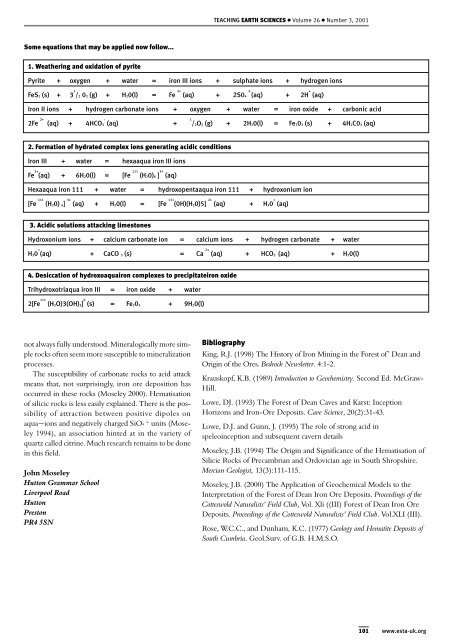teaching - Earth Science Teachers' Association
teaching - Earth Science Teachers' Association
teaching - Earth Science Teachers' Association
Create successful ePaper yourself
Turn your PDF publications into a flip-book with our unique Google optimized e-Paper software.
TEACHING EARTH SCIENCES ● Volume 26 ● Number 3, 2001<br />
Some equations that may be applied now follow...<br />
1. Weathering and oxidation of pyrite<br />
Pyrite + oxygen + water = iron III ions + sulphate ions + hydrogen ions<br />
FeS2 (s) + 3 1 /2 02 (g) + H20(l) = Fe 2+ 2-<br />
(aq) + 2S04 (aq) + 2H + (aq)<br />
Iron II ions + hydrogen carbonate ions + oxygen + water = iron oxide + carbonic acid<br />
2Fe 2+ -<br />
(aq) + 4HCO3 (aq) +<br />
1<br />
/2O2 (g) + 2H20(l) = Fe203 (s) + 4H2C03 (aq)<br />
2. Formation of hydrated complex ions generating acidic conditions<br />
Iron III + water = hexaaqua iron III ions<br />
Fe 3+ (aq) + 6H20(l) = [Fe 111 (H20)6 ] 3+ (aq)<br />
Hexaaqua iron 111 + water = hydroxopentaaqua iron 111 + hydroxonium ion<br />
[Fe 111 (H20) 6] 3+ (aq) + H20(l) = [Fe 111 (0H)(H20)5] 2+ (aq) + H30 + (aq)<br />
3. Acidic solutions attacking limestones<br />
Hydroxonium ions + calcium carbonate ion = calcium ions + hydrogen carbonate + water<br />
H30 + (aq) + CaCO 3 (s) = Ca 2+ -<br />
(aq) + HCO3 (aq) + H20(l)<br />
4. Desiccation of hydroxoaquairon complexes to precipitateiron oxide<br />
Trihydroxotriaqua iron III = iron oxide + water<br />
2[Fe 111 (H2O)3(OH)3] 0 (s) = Fe203 + 9H20(l)<br />
not always fully understood. Mineralogically more simple<br />
rocks often seem more susceptible to mineralization<br />
processes.<br />
The susceptibility of carbonate rocks to acid attack<br />
means that, not surprisingly, iron ore deposition has<br />
occurred in these rocks (Moseley 2000). Hematisation<br />
of silicic rocks is less easily explained. There is the possibility<br />
of attraction between positive dipoles on<br />
aqua~ions and negatively charged SiO4 4- units (Moseley<br />
1994), an association hinted at in the variety of<br />
quartz called citrine. Much research remains to be done<br />
in this field.<br />
John Moseley<br />
Hutton Grammar School<br />
Liverpool Road<br />
Hutton<br />
Preston<br />
PR4 5SN<br />
Bibliography<br />
King, R.J. (1998) The History of Iron Mining in the Forest of’ Dean and<br />
Origin of the Ores. Bedrock Newsletter. 4:1-2.<br />
Krauskopf, K.B. (1989) Introduction to Geochemistry. Second Ed. McGraw-<br />
Hill.<br />
Lowe, DJ. (1993) The Forest of Dean Caves and Karst: Inception<br />
Horizons and Iron-Ore Deposits. Cave <strong>Science</strong>, 20(2):31-43.<br />
Lowe, D.J. and Gunn, J. (1995) The role of strong acid in<br />
speleoinception and subsequent cavern details<br />
Moseley, J.B. (1994) The Origin and Significance of the Hematisation of<br />
Silicie Rocks of Precambrian and Ordovician age in South Shropshire.<br />
Mercian Geologist, 13(3):111-115.<br />
Moseley, J.B. (2000) The Application of Geochemical Models to the<br />
Interpretation of the Forest of Dean Iron Ore Deposits. Proceedings of the<br />
Cotteswold Naturalists’ Field Club, Vol. Xli ((III) Forest of Dean Iron Ore<br />
Deposits. Proceedings of the Cotteswold Naturalists’ Field Club. Vol.XLI (III).<br />
Rose, W.C.C., and Dunham, K.C. (1977) Geology and Hematite Deposits of<br />
South Cumbria. Geol.Surv. of G.B. H.M.S.O.<br />
101 www.esta-uk.org

















